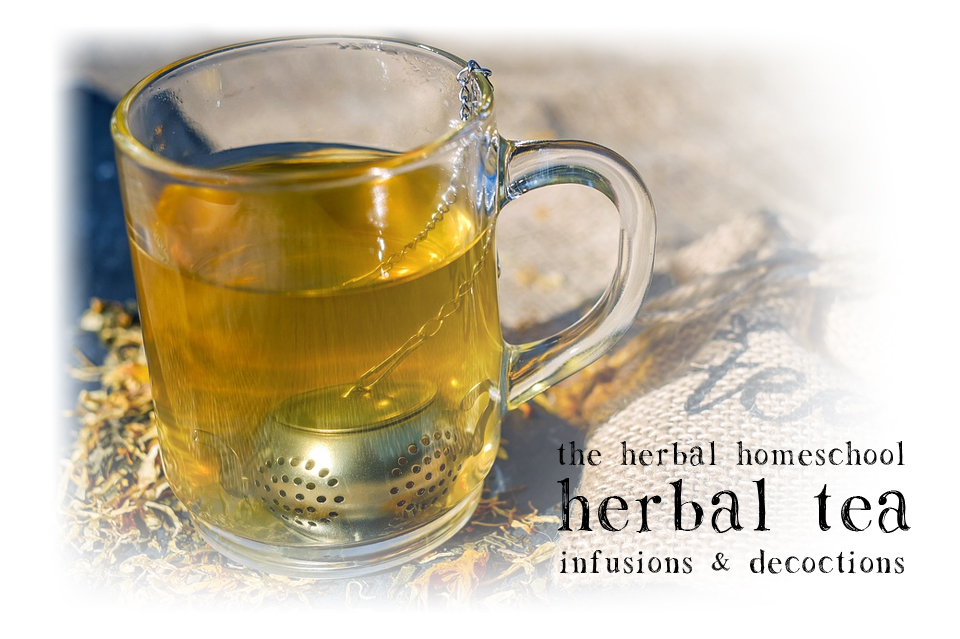Herbal Tea; Infusions & Decoctions
 Teas, Tinctures, Infusions, Decoctions, Oils, Salves, Capsules, etc. The number of different ways to prepare herbs can set your mind spinning! Not to mention the extra ingredients needed such as glycerin or alcohol for tinctures or beeswax for salves.
Teas, Tinctures, Infusions, Decoctions, Oils, Salves, Capsules, etc. The number of different ways to prepare herbs can set your mind spinning! Not to mention the extra ingredients needed such as glycerin or alcohol for tinctures or beeswax for salves.
With so many choices at hand, I decided to stop stalling and begin with the most straightforward; teas.
After all, what could be more simple than putting some crumbly dry herbs in a jar of hot water? Turns out there are many nuances that need to be considered, such as whether to heat the herb up in water and boil, or pour the hot water over the herb and steep, how much herb to use, how long to let it sit, how much to take, and so on. I pushed forward, gathered advice from a number of different herb books, and have compiled the basics here for your enjoyment (and so I don’t forget what I have learned.)
Teas are excellent for treating long term, chronic concerns with their slow & steady tonic effect.
Teas generally considered very safe because they are relatively weak compared to other methods of preparation. Because they are digested by the gastrointestinal track, they will reach & affect the mouth, esophagus, stomach, intestines, kidneys, and bladder as the nutrients absorb into your body.
To make a tea you can either infuse the active principles into water by pouring hot water over the herbs or create a decoction by boiling herbs in water for 10 to 15 minutes. Infusions are used for more delicate parts of plants like leaves and flowers while decoctions are used for tougher parts such as bark or roots.
To make a medicinal-strength infusion, add 4-5 tablespoons of dried herbs to a quart jar and pour hot, almost boiling water over the herbs. “Herbal Healing for Women” by Rosemary Gladstar says that as a rule of thumb use 1 teaspoon of dried herb or 2 tablespoons of fresh herb per cup of water. Let them steep anywhere from 8-10 minutes to overnight. I like to get the most bang for my buck, so I generally let them sit longer to make the tea stronger. Unfortunately, sometimes that turns into forgetting about the tea & wasting the whole batch because it grows mold. So don’t do that; let it steep a reasonable amount of time! Once it has steeped, strain to remove the herbs and compost them.
To make a decoction, “The Herbal Apothecary” suggests boiling 1 oz of herb per 3 cups of water (roughly 1-3 teaspoons per 10 oz of water) for 10 to 15 minutes. Strain and store in the fridge for 2-3 days.
How much do I need to take?
Many herb books that I have read emphasize the importance of consistently taking 2-4 cups of tea a day for a long period of time to treat a chronic condition. However they also recommend taking breaks in your herbal routine, whether taking a 1-2 week break after 12 weeks or stopping for 1-2 days each week. For acute issues, it is better to take less tea more frequently. For example, Herbal Healing for Women strongly suggest treating a fever with 1/4 cup of tea every half hour until it breaks. “Herbs for Children’s Health” suggests between 1/4 and 1/2 cup of tea per serving up to 3 or 4 cups per day. (Note these are for adult servings. I will have a separate post coming on dosing for babies, toddlers, and children.)
This is how to make herbal tea; how to make them taste good is another story for another post. As I am someone who thinks most herbs taste like grass and would much prefer to drink exclusively water, I will be experimenting with herbal combinations, adding stevia, including honey etc. to try to make my tea palatable. I would like to end up with some go-to additives I can toss into my teas based on the ingredients.
